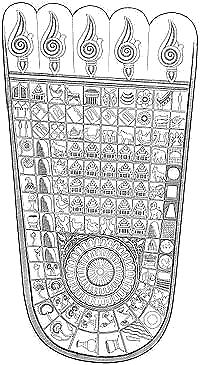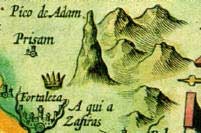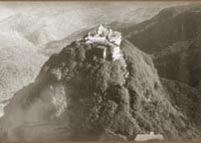 |
Sri Pada: Symbol of inter-faith Harmony
by Rajika Jayatilake
Sri Pada, popularly known in English as Adam's Peak, is a conical mountain 7,360 feet above sea level, soaring clear above the surrounding mountain ranges. However, the altitude is no damper to the thousands of pilgrims who climb the mountain in endless procession during this time of year.
It is not only a Buddhist pilgrimage. There are Hindus, Christians and Muslims too who join the white-clad devotees and brave the chill night mountain air, singing hosannas to the Buddha and the deities, climbing through the dark hours to see the miracle of sunrise from the top of the mountain.
Sri Pada is known as the only mountain in the world considered sacred by the followers of the four major faiths in the world – Buddhists, Hindus, Christians and Muslims. To Buddhists, the imprint at the summit of the mountain is the hallowed footprint of the Buddha, hence the name "Sri Pada". To the Hindus, the footprint is that of God Shiva.

|
 |
To the Christians, it is the footprint of St. Thomas, and to Muslims, it is the foot print of Adam, hence "Adam's Peak". Another name for the mountain by the Sinhalese is "Samanala Kanda" meaning Butterfly Mountain due to the endless flocks of butterflies that wing their way to the mountain with the start of the season.
The Sri Pada pilgrimage is punctuated with tradition. It is customary for first time climbers to bathe at the stream call Seetha Gangula and to pile white cloth on their heads. At Indikatu Pana (place of the needle), pilgrims stop to hang a threaded needle on a shrub on the wayside, marking a spot where the Buddha is said to have stopped to mend a tear in his robe.
It is taboo to talk about how long it takes to climb to the top. When pilgrims meet, they always exchange greetings "karunawai" - "peace". Some groups of pilgrims reduce the monotony of the climb by singing folk songs. Every pilgrim is expected to toll the huge bell at the summit - once for each time they visited. As the deep and solemn peals resonate, the pilgrims become ecstatic.
According to the Mahavamsa, the Great Chronicle of the island, the first person to ascend the holy mountain Sri Pada was King Vijayabahu I (1058-1114), having come to know that atop the mountain is seen the footmark of the Buddha. The story goes he had gathered the information from the pious woman Manimekhala.
A more colourful story is that the king had seen, in the early hours of one morning, angels plucking flowers in his garden. When questioned, one of them had said "We are plucking flowers to worship the footmark of the Buddha atop the Samanalakanda."
The sacred foot print that Dr. John Davy saw in 1817, was ornamented with a single margin of brass and studded with a few gems. These are now not to be seen. He says, "The cavity of the footmark certainly bears a coarse resemblance to the figure of a human foot but much oversized. Whether it is really an impression is not very flattering, if not for its huge size. There are little raised partitions to represent the interstices between the toes, to make it appear a human foot."
The sacred foot print is now on a stone slab at the center of the mountain summit , on a small plateau. The original foot print is beneath the stone slab and is embedded on a large blue sapphire made for protection of the footprint, by an ancient king of Sri Lanka.
The ‘cetiya' situated at the foot of Sri Pada is the peace pagoda erected by the Japanese Buddhists to spread the message of peace throughout the world from which begins the arduous climb to the summit of the Adams Peak.
History records that many distinguished persons, like Ibn Batuta the Arab traveler, and Marco Polo have climbed Sri Pada.
Courtesy: The South Asian Life & Times of January 2003